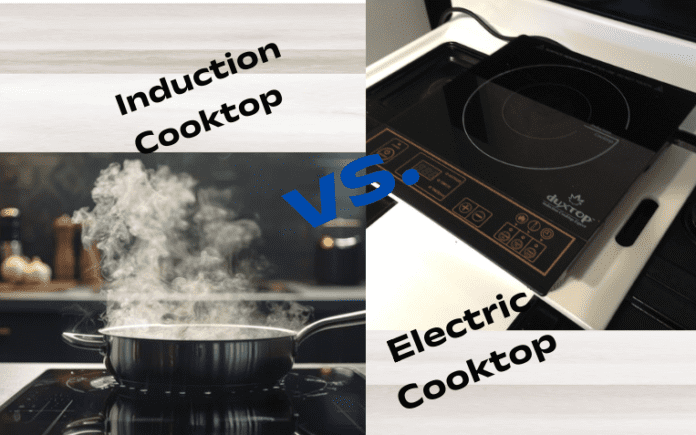Table of Contents
Induction Cooktops vs. Electric
When purchasing a new range or exploring options for a new home, you may be deciding between Induction cooktops vs. Electric. Both types provide power, precision, and performance, delivering quick heat and excellent temperature control. Understanding the differences between induction and electric cooktops can help you make an informed choice for your kitchen.
Induction cooktops are a type of electric cooktop, as both rely on electricity for power. When comparing induction cooktops to electric cooktops, it specifically refers to traditional electric ceramic cooktops that do not utilize induction technology.
What is an Induction Cooktop?
Induction cooktops use electromagnetic energy to heat pots and pans directly, rather than relying on an open flame or electric coils. This technology requires cookware made of ferrous materials (magnetic materials), such as cast iron or certain types of stainless steel.
How do Induction Cooktops Work?
Induction cooktops are a type of electric cooking appliance that uses coils beneath the surface to generate heat without gas. They are highly efficient, utilizing about 90% of the electricity for cooking, which means minimal energy waste and instant heat with precise temperature control.
Induction heating operates through electromagnetic radiation; as electricity flows through the coil, it heats the cookware directly. This design prevents residual heat since the air between the cooktop and pan remains cool.
Pros and Cons of Using Induction Cooktop
Induction cooktops provide quick cooking, easy cleanup, and other benefits, but they do have some drawbacks.
Pros of Induction Cooktops
- After cooking, cooktops remain cool to the touch.
- Cleaning is easier because the surface remains cool.
- There is no residual heat, which means cheaper energy expenses and a cooler kitchen environment.
- Faster cooking times, boiling water in half the time as done by gas.
Induction cooktops are not only faster to cook, but they are also easier to clean because they have a flat cooking surface with no grates or burners. Induction cooktops also allow for rapid adjustments to cooking temperatures.
Cons of Induction Cooktops
- Typically more expensive than electric alternatives.
- Necessitate the use of induction-compatible cookware, such as cast iron or stainless steel.
- Creates a buzzing or humming sound when operating at higher heat settings.
- Magnetic field can disrupt digital thermometers.
- Induction cooking might have a learning curve.
Induction cooking can be unfamiliar for new users, as there’s no visible glow under the glass like with traditional cooktops. However, some manufacturers now offer a simulated flame pattern to indicate when the cooking area is active.
What is an Electric Cooktop?
Electric cooktops operate using electric coils or smooth top surfaces. They are available in two primary styles: coil and smooth top. Coil cooktops feature raised elements, while smooth tops offer a sleek, integrated design.
How do Electric Cooktops Work?
Also known as radiant cooktops, electric cooktops generate centralized heat through an electric current flowing through a metal coil beneath a glass or ceramic surface. The coil heats up and glows due to electrical resistance, transferring heat via infrared energy to the cookware. This means the burner heats the pot or pan directly.
Electric cooktops retain residual heat for a period, which is why they often feature an indicator light to signal that the burner is still warm.
Pros and Cons of Using Electric Cooktops
Electric cooktops are simple to install and work with a wide range of cookware, but they lack the benefits of induction cooktops.
Pros of Electric Cooktop
- Easy installation and use.
- Provide some residual heat that can assist in keeping the dish warm or simmering.
- Provide controlled and managed heat, which can also reduce energy expenses.
Like induction cooktops, electric cooktops offer easy cleanup due to their smooth, flat surface, which provides stability for pots and pans. Additionally, one advantage of electric stovetops is their easy installation, requiring only a grounded outlet.
Cons of Electric Cooktop
- Residual heat might be potentially harmful, especially in houses with children.
- Electric cooktops take longer to heat up, which increases cooking time.
- Coils frequently create uneven dispersion of heat.
Radiant and coil electric cooktops take longer to heat and cool compared to induction cooktops, leading to more heat loss. As a result, you must wait for the surface to cool completely before cleaning.
Key Differences Between Induction Cooktops vs. Electric
| Feature | Induction Cooktops | Electric Cooktops |
| Heating Method | Uses electromagnetic field | Heats burners directly via coils |
| Cookware | Requires magnetized cookware | Any cookware compatible |
| Price Range | $800 – $6,000 | $200 – $3,000 |
| Response Time | Instant heat and quick adjustments | Slower heating and cooling |
| Control | Better control with immediate response | Less control, retains heat |
| Cleaning | Easy to clean, flat glass surface | Easy to clean, but may have spills |
| Energy Efficiency | 5-10% more efficient | Less efficient due to heat loss |
| Safety | Safer; only heats with compatible pan | Less safe; can heat without cookware |
| Wear and Tear | Prone to scratches; care needed | Similar wear concerns; handle gently |
Induction Cooktops vs. Electric: Which is Easier to Use?
Switching between electric cooktops is straightforward, as you’ll quickly adapt to any minor differences in controls. However, transitioning to an induction cooktop requires more time to adjust to its faster heating and cooling. You’ll need to monitor your cooking more closely until you become familiar with the new appliance.
Induction Cooktops vs. Electric: Which is Better?
If you’re moving from one electric cooktop to another, the learning curve is minimal. In contrast, switching to an induction cooktop demands an adjustment period due to its unique cooking method. Expect to spend time learning how quickly it heats and cools, requiring closer attention to your cooking during the transition.
How to Choose the Right One
Choosing between an induction and an electric cooktop is a personal decision based on your preferences and priorities. If you prefer familiarity, stick with an electric cooktop. However, if you want fast, even heating, lower energy costs, and enhanced safety, an induction cooktop is the better choice.
For energy efficiency, induction cooktops are preferable. Conversely, if you seek affordability and compatibility with all cookware, an electric cooktop is ideal. Ultimately, your cooking style, kitchen needs, and budget will guide your decision.
Conclusion
The choice between Induction Cooktops vs. Electric largely depends on your cooking habits and kitchen needs. Induction cooktops offer faster cooking, energy efficiency, and a cooler kitchen environment, but they require specific cookware and can be pricier. Conversely, electric cooktops are easy to use, compatible with a wide range of cookware, and provide a familiar cooking experience, though they may not match the efficiency and speed of induction. Ultimately, your cooking style, safety preferences, and budget will guide you in making the best choice for your kitchen.
Apart from that if you want to know about “Kitchen and Bath Remodel | Common Mistakes to Avoid” then please visit our “Home Improvement” Category.
FAQs
Induction stoves are a tempting alternative to electric stoves since they are faster, safer, and require less energy to heat your home.
It demands a different rhythm and pace of cooking than gas or electric cooktop, and it can take time to adjust.
Many types of cookware are not suitable for use on an induction cooking surface. Aluminum, aluminum foil, copper or copper clad, glass/ceramic, and some stainless steel.
















